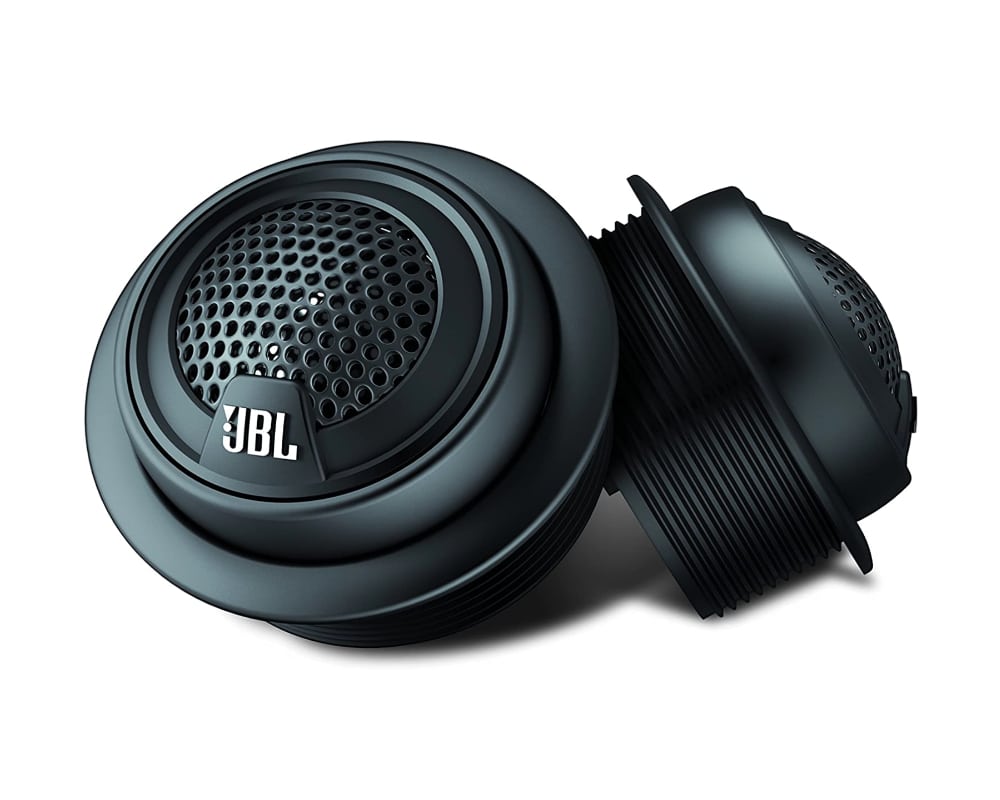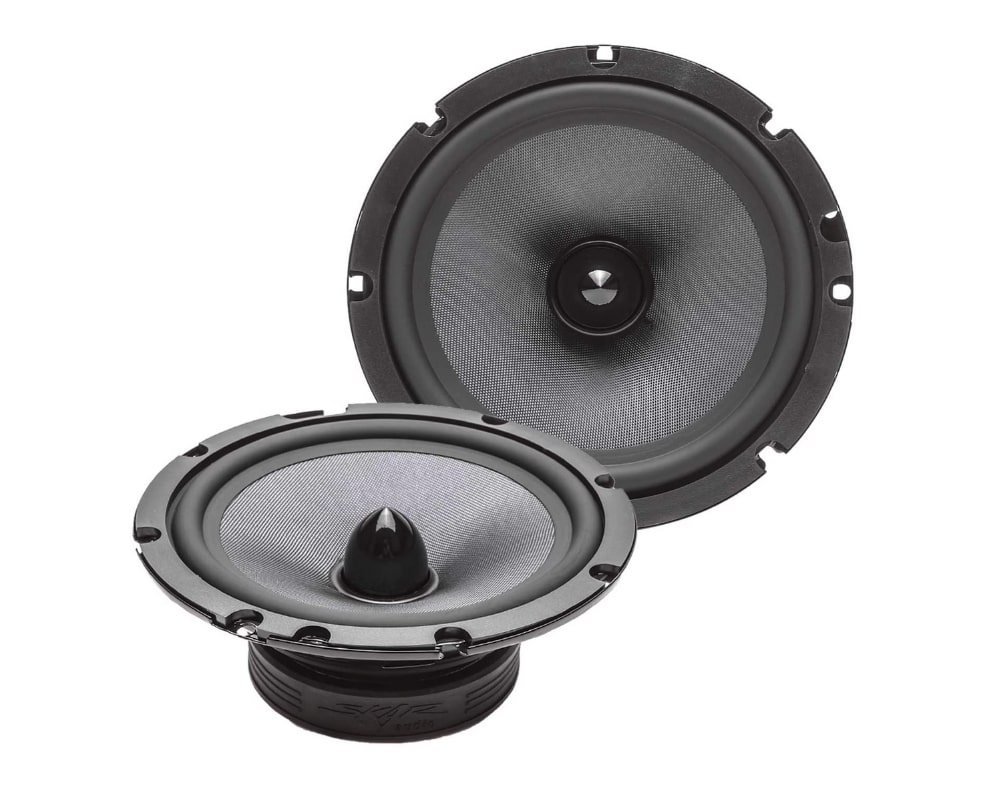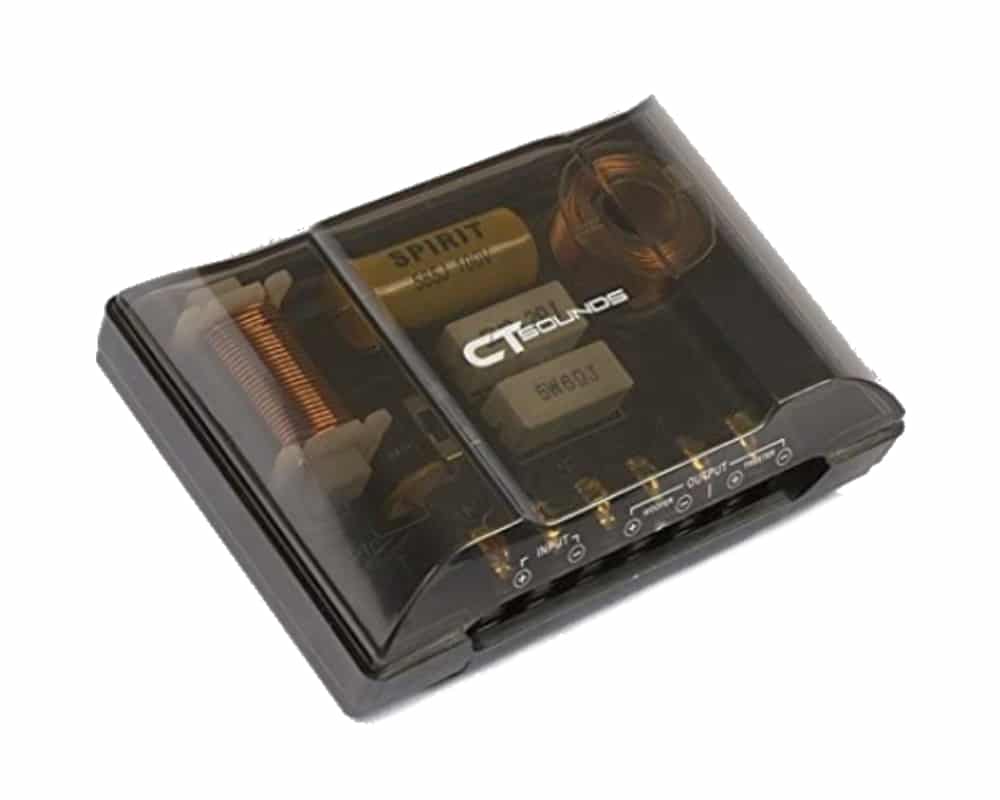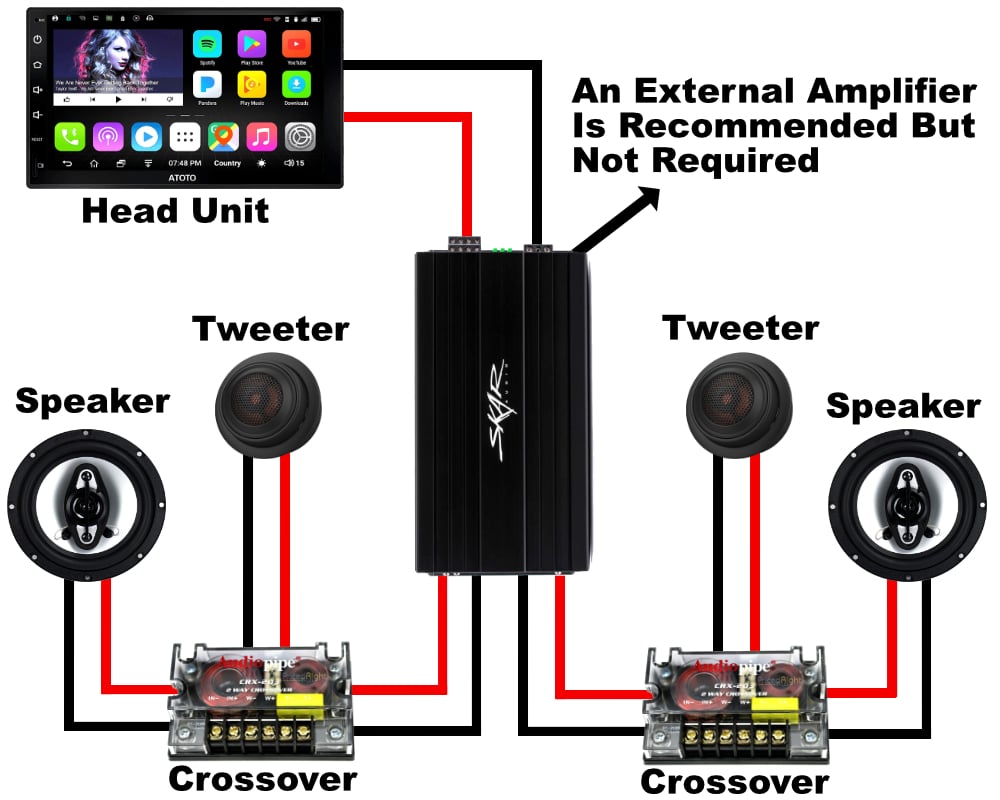What Are Component Speakers? More Car Audio Quality
All vehicles today come with standard audio components, including speakers near the dash and also in the doors or at the back of the vehicle near the rear window. Generally speaking, they are of decent quality and satisfy the majority of the driving public.
Many high-end vehicles have better quality systems installed, and that applies to the speakers as well. However, many car enthusiasts are looking for better quality systems to augment the enhancements they have made to the rest of the car.
The outrageous deep bass sounds emanating from many high-powered cars serve to attract onlookers. They compete for attention, and you can hear them from a mile away. Audio buffs appreciate the good quality sound, whether it is in your home or their vehicle.
Many are turning to component car speakers to deliver high-quality sound to improve their listening experience – tweeters matched with mid-bass drivers to produce a range of high-quality sound. Some of the information out there is a bit misleading. That’s why we will be discussing the difference between component and other speakers.
What are component speakers?
Tweeters are used to deliver high frequencies, while mid-bass drivers are producing mid-range frequencies. While tweeters are great at producing high frequencies, they are not good for lower frequencies and sometimes produce distortion at these lower frequencies, which does not make for great listening music.
Similarly, mid-range speakers for your car are great at producing mid-range frequencies but not efficient at high-range frequencies. They can also distort sounds at these high levels.
Matching tweeters and mid-bass drivers together along with a controller to manage which frequencies go to which speaker gives you a set of component speakers that delivers great sound without the distortion caused by speakers that are not designed to carry specific frequencies.
They are designed to provide outstanding sound and to limit harmful distortion and other unpleasant sounds to make your music listening much more enjoyable. Component speakers along with low-range woofers can deliver great music at all frequency levels.
Different Parts of a Component Speaker System
As mentioned, there are three parts to component speaker sets or systems. They are:
- Tweeters
- Midrange speakers
- Crossovers
These components are engineered to work closely with each other, with the crossover being the brains of the three components. Tweeters are best at delivering the high-end frequencies, while midrange speakers are best at delivering midrange frequencies.
The crossover device detects the frequencies delivered to the system and decides which speaker is best equipped to present the sound. An important distinction between component speakers and factory car audio speakers is that each component in a component system is installed in a separate location in the vehicle.
A factory audio package often has a woofer and tweeter installed at the same location providing high-quality sound but not near what a component system can provide. Component speakers installed in different locations throughout the car can often provide concert-level music since you are immersed within the sound coming to you from multiple directions.
Tweeters

Tweeters deliver frequencies located on the top of the frequency range. For example, the high vocals and percussion instruments are reproduced by the tweeters. High frequencies tend to be more directional. All the frequencies above a fixed point will be assigned to the tweeters.
Furthermore, these woofers should typically be installed at ear level while maintaining the same distance from your ear as the woofers or mid-range speakers. This helps to ensure that the different frequencies reach your ear at the same time. Speaker stands or mounts are used for this purpose.
Look for neodymium magnets when you purchase the tweeter separately. This material allows for the tweeter to reproduce frequencies with more force and accuracy. The tweeters are usually installed on the sail panels or the dashboard of the vehicle.
Midrange speakers

Midrange speakers or component woofers are often located in the same vehicle’s factory locations for the factory speakers. This makes installation a bit easier. Installation of the speakers is often in the driver and passenger doors.
Remember that the mid-range speakers and the tweeters should be approximately the same distance from your ear to avoid sound delays and to provide maximum quality.
Some of the features to look for are the butyl rubber as well as aluminum coil surrounds. These features help to absorb the sound coming from the speaker and thus produce a better sound experience.
Crossovers

The crossover is a relatively simple device that sends the high frequencies to the tweeter and the lower frequencies to the midrange speakers. It receives the signals from the car stereo systems, cd player, or another unit you may have in your car and routes the signal as explained.
The crossover can be placed anywhere out of sight. However, remember that you need to run wires from the unit to each of the speakers. Coaxial speakers typically do not require a crossover, and this device will be included when you purchase your component car audio systems.
How do component speakers work?
Component speakers are made up of three components – woofers and tweeters, and crossovers. Woofers that deliver bass and midrange signals, tweeters that deliver upper high and midrange frequencies, and a speaker crossover. Each speaker only delivers the range of frequencies it is designed for, which decreases the amount of distortion.
It is the speaker crossover, made up of capacitors and inductors designed to filter out the appropriate frequencies before delivering the signal to the appropriate woofer. The capacitors and inductors block the high frequency from being delivered to the woofer.
A separate circuit within the speaker crossover also made up of inductors and capacitors also blocks the low frequencies from being passed to the woofer. The speaker crossover receives inputs from the radio or amplifier if one is installed in the car.
There are two outputs, one for the tweeter and one for the woofer. The speakers are mounted separately and do not interfere with each other physically the way that some factory combination speakers do. A tweeter installed with a woofer is known as a coaxial speaker system.
Wiring Component Speakers Explained

Wiring is relatively simple. However, It is important to connect the right wires to the correct connections. The input is from the radio or amplifier and must be connected to the input of the crossover. The crossover can be installed in any location as long as it is physically protected and dry.
The woofer can be installed in the same location the factory speakers were installed in the vehicle. Wiring must run from this location and terminate on the crossover on the connections marked woofer output.
Since the tweeter is a separate speaker, it must be physically installed in your vehicle not far from the woofer and near the same height as your ear. Before selecting a location to install the tweeter and perhaps fabricating a mount for the speaker, consider how the wiring will be installed.
Many come with a wiring kit or wiring instructions. Make sure each speaker is wired correctly before turning the system on. Can you run it inside a doorpost, on the floor out of sight, etc.? The speaker wire must be connected to the tweeter output on the crossover device for the tweeter.
Component speakers vs. Regular speakers
Regular speakers are typically installed at the factory in your vehicle unless you purchase a high-end vehicle with an audio upgrade, either coaxial or component speakers.
Regular speakers have a standard single cone with perhaps a Whizzer cone in the center for higher frequencies. They typically have poor high-end responses. Treble sounds tend to sound distorted at the higher frequencies and do not deliver quality sounds.
Anyone looking for quality music delivery at the higher-end frequencies typically delivered by a tweeter will be disappointed with regular speakers. Component speakers have individual speakers designed to deliver frequencies in their respective ranges.
Woofer or mid-range bass have excellent sound characteristics at the lower frequencies. Tweeter speakers also have excellent frequency response and sound delivery at higher frequencies. In addition, the crossover limits frequencies that would cause distortion being sent to the respective woofer.
One of the great features of these component speakers is that they are free to operate from any physical interference. The more resonant low frequencies produce by these drivers will provide a solid foundation for detailed highs, and as such, you’ll be able to get full-range sound without worry!
The differences between coaxial and component speakers are minimal for most people. Before deciding on a component or coaxial system, consider the installation challenges for your vehicle.
Benefits of Component Speakers
Component speakers have some very strong benefits that audio files will appreciate. They are significantly improved over factory full-range speakers and have strong benefits compared to coaxial car speakers.
- Separate speakers for high and low frequencies
- Cleaner sound
- Better at separating the high and low frequencies
- Tweeter speaker placement improves the sound delivered to your ear
- Crossover system designs are generally improved compared to coaxial designs
- Component speakers tend to use better quality materials
- Tweeters tend to use more rigid high-performance designs
- Improved frequency response overall
- Power ratings are usually higher
- Improved connector terminals and installation components
Inexpensive component speaker systems can deliver very good quality sound. Although they are more difficult to install, a proper installation improves the sound listening quality.
The mid-bass speakers can be installed in the same location as the factory speakers, while the tweeters should be installed on the dash at ear level to give the impression of being near the stage listening to the music.
Crossover
The crossover component sorts out the high and mid-range frequencies and delivers them to the appropriate speaker. Installation of the crossover is relatively easy; however, location is important.
Most consumers install the crossover under the dash. The crossover should be mounted in locations away from any source of moisture. Keep the crossover away from the floor or the bottom of the inside of the door.
The crossover allows you to separate all the frequencies delivered to the car stereo to the individual speakers. Coaxial speakers do not have this feature, and it is often recommended to upgrade to component speakers to improve your listening experience.
Sound staging
Mounting the tweeters on the dash vs. near the rear window can make a difference in the sound delivery impact. Rather than receive the sound from behind you, mounting the tweeters on your dash gives the impression of sitting near the stage with the sound washing over you. Careful mounting and proper location can provide the same effect as sitting near the stage in a live concert.
Clarity
Mid-bass speakers tend to distort high-frequency sounds. Likewise, tweeters tend to distort low-frequency sounds. Distortion is the result unless you are using a component system to control the delivery of frequencies to the appropriate speaker. Using a crossover system in your component speaker system improves the clarity and decreases the amount of distortion.
Better Stereo Imaging
Consumers can improve stereo imaging by installing the tweeters on the dash delivering high-quality sound from the front rather than the back of the car. The direction of the sound improves the imaging for many people giving the impression of sitting in front of the stage. The listening angle and height improves the quality of your experience during music playback.
Power handling
Power handling is often improved when using component car speakers. Confirm specifications and features before purchasing a component set.
Some will include a separate tweeter volume control function to prevent overload of the tweeter and to control a harsh sounding sound in situations where the tweeter is being overloaded. There is also circuit protection which helps to avoid burnout of the circuits and the speakers.
Are component speakers better than coaxial speakers?
Coaxial speakers have the tweeter and the midrange speaker combined in one unit. They provide better performance than factory full-range speakers, and they can be placed in the same physical location as the factory-installed speaker.
Many people feel that they provide comparable sound quality to component speakers. However, at least three major differences are affecting sound quality. Component vs. coaxial systems offer improved power handling, better distortion handling, and better crossover capability, which improves sound quality.
Component systems with the tweeters mounted on the dash provide improved imagery and sound listening capabilities giving the impression of sitting in front of the stage listening to the performance.
There are some very good coaxial speakers. However, it is generally felt that the materials used in component speakers are of better quality, come with speaker installation accessories and better connector terminals.
Installation of component speakers is more challenging than coaxial speakers since coaxial speakers can usually be installed in the factory speaker location.
Do component speakers need an amp?
The short answer is no; component speakers do not need to be connected to an amp. The output of the car audio system can be connected directly to the external crossover system to play great music, either live or pre-recorded.
Car amplifiers can also be connected to component systems. Purchasing a component unit with power control capability in the crossover unit may be beneficial to avoid causing damage to the component speakers if the power levels exceed the capabilities of the speakers.
Before connecting any device, radio, or amp, always confirm the specifications and power levels that the component system can tolerate. If your external amplifier puts out 100 watts RMS and your door speakers are rated for 75 watts, and there is a danger of damaging the component system if the amp is turned up to full power mode.
Most technicians at the audio store can help ensure that matching power levels are taken into account before making your purchase.
Should I put component speakers in the back?
Component speakers can be installed in the back near the window. There are often great locations to mount the speakers without damaging your vehicle. Some issues should be considered before making this decision.
Component speakers separate the high from the mid-range frequencies and deliver the sound to the appropriate speaker that is optimized for those frequencies, .e.g., high frequencies are delivered by the tweeters.
Optimum sound performance is best when the tweeters are located in front so that you listen to the sound as it arrives in front of you instead of behind you. This slight position difference improves the imagery of feeling like you are sitting in front of a stage listening to the band.
The tweeter and the mid-range speakers are also relatively close together if you mounted the mid-range in the doors where the factory woofers were installed. This positioning offers further improvement.
What is better 2-way or 3-way speakers?
Three-way speakers are an extension of two-way coaxial speakers. A two-way speaker has both the mid-range speaker and the tweeter installed together. A three-way speaker adds a small speaker to provide improved sound performance. It usually is an additional tweeter or mid-range woofer.
They are all combined in the same housing. Some three-ways add a tiny piezo tweeter which can exceed the frequency capabilities of standard tweeters. Well-designed models offer accurate sound and a truly flat frequency response which is ideal. Three-way speakers tend to be more expensive.
Not everyone can discern the difference in sound quality, and it may not be worth the extra money to purchase a three-way coaxial speaker that is being mounted in the door or at the back of the vehicle where the factory woofers were installed.
High-quality 2-way component speakers can deliver great sound quality at reasonable prices. Coaxial and component speakers deliver better sound than factory car speakers. Coaxial home speakers are also of good quality. Component speakers can be installed as a 2way component with both speakers side by side.
Which speaker offers better sound quality?
There are three categories of speakers intended for use as speakers in your car. They are:
- Single cone, factory-installed speakers
- Coaxial speakers who have the mid-range and tweeter together in one speaker
- Components speakers, which separate the three parts of the system, the crossover, tweeter, and midrange.
Coaxial speakers offer great quality, are less expensive, and easy to install. Component speakers offer optimal sound quality compared to coaxial speakers but are more expensive, and usually, installation is a bit more complicated.
If you are looking to maximize your car audio experience, component speakers are a great option. They are more a bit difficult to install and require more complex cable connectivity, but you will notice a difference in sound quality.
Unlike coaxial speakers, component car speakers come with separate tweeters, woofers, and crossovers which are installed separately in your vehicle. High-quality component speakers are recommended for anyone who wants better sound quality as well as those who want to achieve maximum output from their car audio systems.
Component car speakers come with a crossover that enables you to reduce the range of frequencies that each needs to reproduce accurately. To achieve the best sound possible, it is recommended to purchase an external amplifier as well as high-quality car stereo receivers in combination with the component set.
What are the best component speakers for car audio?
When you are looking for the best component speakers, JL Audio is a brand that should be at the top of your list. With their stellar reputation in designing woofers and high-quality audio equipment, they’re sure to have what it takes to provide you with an exhilarating listening experience while on the go.
Besides JL Audio, you can also check out brands like Pioneer, Alpines, and Polk Audio. Make sure that you select the correct mounting depth and size before you go ahead and purchase them. You also need to make sure that the separate woofers are RMS rated so as to be able to deliver the correct power to them.
Should I purchase an aftermarket head unit as well?
Purchasing a head unit that comes with a high-quality equalizer will help you customize the sound output based on your personal taste. The head unit will allow you to adjust bass and treble settings as well as mid-range settings using a graphic equalizer or parametric equalizer.
Parametric equalizers are more expensive than graphic equalizers, but they offer better quality and can be adjusted in more precise frequencies. The combination of component woofers and a high-quality head unit will provide you with more refined sound output.
Summary
Compared to other speakers, the component speakers offer more flexibility and better sound quality. The higher price is their main disadvantage. Some of the features to look for are the butyl rubber and neodymium magnets.
You should combine the component speakers with a subwoofer or a great head unit to get a good bass output. These woofers are recommended for the ones who want to achieve a high-energy sound output and those looking to get everything out of their car audio systems.
Last Updated on: March 16, 2025

